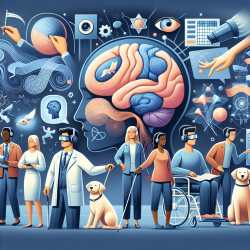The field of special education and therapy is constantly evolving with new research findings that challenge existing paradigms and open new avenues for enhancing practice. One such groundbreaking study is "Peripheral sounds elicit stronger activity in contralateral occipital cortex in blind than sighted individuals," which provides valuable insights into cross-modal activation and its implications for auditory processing skills.
Understanding Cross-Modal Activation
The study explores how peripheral sounds can activate the visual cortex in both blind and sighted individuals. Interestingly, it was found that this activation is more pronounced in blind individuals, suggesting that the absence of visual input enhances neural activity in response to auditory stimuli. This phenomenon is known as Auditory-evoked Contralateral Occipital Positivity (ACOP), which occurs between 200–450 ms after sound onset.
Implications for Practitioners
For practitioners working with visually impaired or blind individuals, these findings underscore the importance of leveraging auditory stimuli to enhance sensory processing skills. Here are some practical applications:
- Sensory Integration Therapy: Incorporate peripheral auditory stimuli in therapy sessions to stimulate cross-modal activation and improve sensory integration.
- Auditory Training Programs: Develop programs that focus on enhancing spatial hearing abilities by using task-irrelevant noise bursts to activate the visual cortex.
- Customized Learning Plans: Tailor learning plans for visually impaired students by integrating auditory cues that can enhance attention and cognitive processing.
The Path Forward: Encouraging Further Research
This study opens up numerous possibilities for further research. Practitioners are encouraged to explore how different types of auditory stimuli can be used to activate other sensory areas and improve overall cognitive functioning. Additionally, understanding the neural mechanisms behind cross-modal plasticity can lead to more effective therapeutic interventions.
The integration of such research findings into practice not only enhances the skills of practitioners but also significantly improves the quality of life for individuals with sensory impairments.










